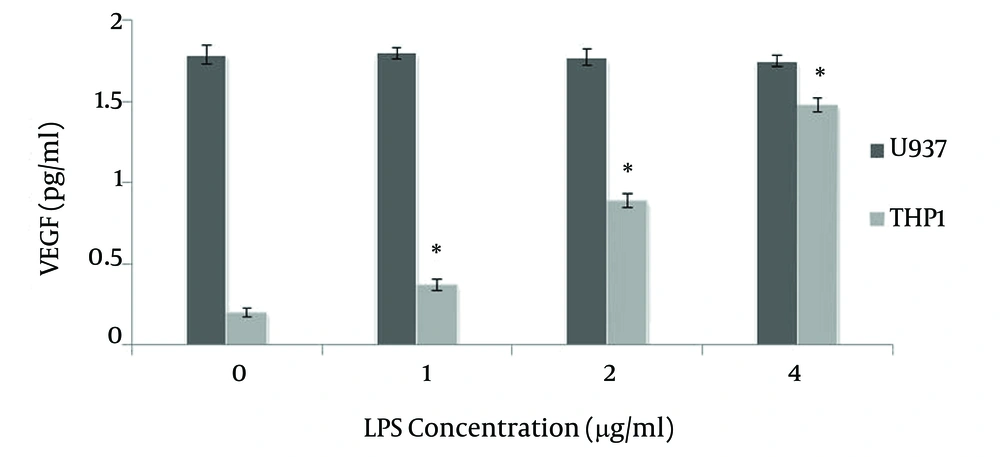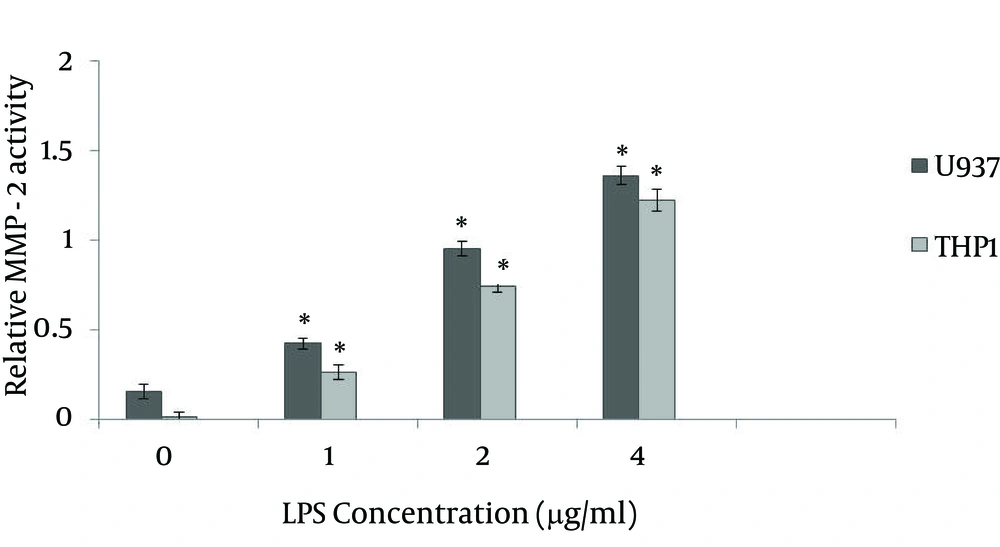1. Background
Angiogenesis (creation of new vessels or replenish of the pre-existing vascular networks) plays a critical role in some pathological conditions such as tumor expansion and metastasis (1-3). Many factors have involved in angiogenesis including hormones, cytokines and Matrix Metalloproteinases (MMPs) (4-6). Vascular Endothelial Growth Factor (VEGF) is a cytokine which is produced by a number of cells and has a key role in angiogenesis and inflammation (5, 7). VEGF is overexpressed in many malignant cancers (8, 9). The increased VEGF level has been reported in serum of leukemia patients and also leukemia cell culture supernatants (8, 10). MMPs were a large group of enzymes that have break down extracellular matrix result in tissue remodeling and have an important role in angiogenesis and inflammation (6, 11). Lipopolysaccharide (LPS) is endotoxin constitute the major component of outer membrane in gram negative bacteria (12). The induction of angiogenesis by LPS has been shown (13-15). Also LPS has increased the VEGF production in peripheral blood mononuclear cells in vitro (16). Moreover the effects of LPS in leukemiogenesis and in vitro activation of leukemic cells have been reported (17, 18). Besides the angiogenesis and angiogenic factors have important role in leukemia (19, 20).
2. Objectives
In this study the effect of LPS on angiogenic factors in two leukemic cell lines has been studied in vitro.
3. Materials and Methods
3.1. Reagents
RPMI-1640 medium, penicillin, streptomycin, Lypopolysaccharide (LPS), and Trypan Blue (TB) were from sigma (USA). Fetal Calf Serum (FCS) was from Gibco (USA). Microtiter plates, flasks and tubes were from Nunc (Falcon, USA). VEGF standard ELISA kit has obtained from R and D company (USA).
3.2. Cell Lines
Human leukemic monocytes [U937 (NCBI C130] and THP1 (NCBI C563)], have obtained from NCBI (National Cell Bank of Iran, Pasteur Institute, Tehran, Iran). The cells have maintained in RPMI-1640 medium supplemented with 10% FCS and incubated in 5% CO2 at 37°C.
3.3. Cell Culture and Treatment
The method has described in detail elsewhere (10). Briefly, the human leukemic cells were cultured in RPMI-1640 medium supplemented with 10% FCS, penicillin (100 IU/mL) and streptomycin (100 µg/mL) at 37°C in 5% CO2. The cells were seeded at a density of 106 cells/mL and prior to experiments were treated in fresh medium. Then the cells were incubated with different concentrations of LPS (0 - 4 µg/mL) for 48 hours. The supernatants of cell cultures were collected, centrifuged and stored at -80°C for next experiments. All experiments were done in triplicate.
3.4. Evaluation of VEGF Production by ELISA
The amount of VEGF have secreted in the cell culture supernatants by human leukemic cell lines was measured with the Quantikine human VEGF ELISA kits (R and D systems) according to the manufacturer’s instructions. This assay uses the quantitative sandwich enzyme immunoassay technique. Complete RPMI medium was used as control and human recombinant VEGF165 was employed as standard for drawing the standard curves.
3.5. Evaluation of MMP-2/MMP-9 Activity by Gelatin Zymography
MMP-2/MMP-9 activity in cell-conditioned media was evaluated by gelatin zymography technique according to the modified Kleiner and Stetler-Stevenson method (21). Briefly cell culture supernatants were subjected to Sodium Dodecyl Sulfate Polyacrylamide Gel Electrophoresis (SDS-PAGE) on 10% polyacrylamide gel copolymerized with 2 mg/mL gelatin A in the presence of 0.1% SDS under non-reducing conditions at a constant voltage of 80 V. After electrophoresis, gels were washed in 2.5% Triton X-100 for one hour to remove SDS and then incubated in a buffer containing 0.1 M Tris-Hcl, PH 7.4 and 10 mM CaCl2 overnight at 37°C. Afterwards the gels were stained with 0.5% Coomassie Brilliant Blue and then destained. Proteolysis activities of enzyme were detected as clear bands of gelatin lysis against a blue background. The relative intensity of lysed bands to control were measured by using UVI Pro gel documentation system (GDS_8000 system) and expressed as relative gelatin lytic activity.
3.6. Statistical Analysis
VEGF level quantification and relative gelatinolytic activity of MMP-2/MMP-9 in cell-conditioned media was performed in three independent experiments and the results were expressed as Mean ± SEM. Statistical comparisons between groups were made by analysis of variance (ANOVA). P < 0.05 was considered significant. Test of multiple comparison of Tukey was applied (5%) for statistically significant differences. The software SPSS 11.5 and Excel 2003 used for statistical analysis and graph making respectively.
4. Results
4.1. Effect of LPS on VEGF Production in Human Leukemic Cell Lines
Results depicted in Figure 1, demonstrate that U937 cells produced a large amount of VEGF without any stimulation and LPS did not show any significant effect on VEGF production by these cells.
The leukemic cells (1 × 106 cells/mL) were cultured in complete RPMI-1640 medium and then were stimulated with different concentrations of lypopolysaccharide (LPS) (0 - 4 µg/mL) for 48 hours. At the end of incubation, VEGF concentration in conditioned medium was quantified by ELISA. Data are Mean ± SEM of three independent experiments.*P < 0.05 was considered significant.
Furthermore according to our findings, VEGF production was rather low in unstimulated THP1 cells but LPS significantly increased VEGF production in these cells after 48 hours incubation time dose dependently as can be seen in Figure 1 (P< 0.05).
4.2. Effect of LPS on MMP Activity in Human Leukemic Cell Lines
4.2.1. Effect of LPS on MMP-2 Activity in Human Leukemic Cell Lines
When U937 cells cultured without any stimulation, faint bonds related to MMP-2 activity were detectable and LPS significantly increased MMP-2 activity in U937 cells after 48 hours incubation time in comparison with untreated control cells. The enhancing effect of LPS on MMP-2 activity in U937 cells was dose-dependent as has depicted in Table 2 and Figure 2 (P < 0.05).
| Cell Lines | LPS Concentratio, µg/mL | ||
|---|---|---|---|
| 1 | 2 | 4 | |
| 0.42 ± 0.032, 0.00094 | 0.95 ± 0.04, 0.000017 | 1.36 ± 0.05, 0.000016 | |
| 0.26 ± 0.04, 0.00534 | 0.74 ± 0.035, 0.00772 | 1.22 ± 0.06, 0.00046 | |
The U937 leukemic cells (1 × 106 cells/mL) were cultured in complete RPMI-1640 medium and then were stimulated with different concentrations of lypopolysaccharide (LPS) (0 - 4 µg/mL) for 48 hours. At the end of incubation, the MMP-activity in conditioned medium was quantified by gelatin zymography. Data are Mean ± SEM of three independent experiments.*P < 0.05 was considered significant.
However MMP-2 activity in unstimulated THP-1 leukemic cells was not detectable and LPS induced MMP-2 activity in these cells after 48 hours incubation time dose dependently compared with untreated control cells as it has shown in Table 2 and Figure 2 (P < 0.05).
4.2.2. Effect of LPS on MMP-9 Activity in Human Leukemic Cell Lines
When U937 cells cultured alone with no stimulus, faint bands related to MMP-9 activity have detected. LPS stimulation, significantly increased MMP-9 activity in U937 cells compared with untreated control cells. The LPS -increased MMP-9 activity in U937 cells was dose-dependent as illustrated in Table 3 and Figure 3 (P < 0.05).
| Cell Lines | LPS Concentratio, µg/mL | ||
|---|---|---|---|
| 1 | 2 | 4 | |
| 0.48 ± 0.04, 0.0011 | 1.36 ± 0.03, 0.0000051 | 1.43 ± 0.045, 0.0000096 | |
| 0.29 ± 0.03, 0.0039 | 0.82 ± 0.052, 0.0013 | 1.3 ± 0.056, 0.0006 | |
The THP1 leukemic cells (1 × 106 cells/mL) were cultured in complete RPMI-1640 medium and then were stimulated with different concentrations of lypopolysaccharide (LPS) (0 - 4 µg/mL) for 48 hours. At the end of treatment, MMP-9 activity in conditioned medium was measured by gelatin zymography. Data are Mean ± SEM of three independent experiments. *P < 0.05 was considered significant.
Nevertheless MMP-9 activity in unstimulated THP-1 leukemic cells was not evident and LPS induced MMP-9 activity in these cells after 48 hours incubation time dose dependently compared with untreated control cells as it has shown in Table 3 and Figure 3 (P < 0.05).
5. Discussion
The results of this study have shown that U937 and THP1 leukemic cells were potential producers of VEGF, MMP-2 and MMP-9. Accordingly, U937 cells have produced a great amount of VEGF without any stimulus and LPS has not shown any significant effect on VEGF production by U937 cells. Whereas THP1 cells have produced an evident amount of VEGF without stimulation and LPS has significantly increased VEGF secretion in this cell line. Therefore our results have shown that there are various patterns of VEGF production in leukemic cells and LPS had different effect on VEGF production in different leukemic cells. Consequently sensitivity of various leukemic cells to LPS-induced VEGF secretion is different. Diverse patterns of VEGF expression in tumorous and normal tissues have been revealed and different cancers exhibit different profiles of VEGF secretion (22-24). VEGF has a key role in tumor expansion and metastasis (25, 26) and is an important biomarker of tumor (27). Thus VEGF might be a good prognostic and diagnostic marker (28-31). Similar to our findings, the presence of VEGF-C protein in supernatants of PMA-differentiated HL-60 leukemic cells after LPS stimulation has shown (32). Also increase of VEGF production by LPS in peripheral blood mononuclear cells has been revealed in vitro (16). Moreover LPS treatment of murine skin wounds with topical LPS has increased the secretion of some growth factors including VEGF at the wound site (33). Furthermore induction of angiogenesis by LPS has been shown (13-15). In addition VEGF has a key role in angiogenesis (5, 7). So the induction of angiogenesis by LPS might be in part due to its stimulatory effect on VEGF production. Currently the anti- leukemic effects of VEGF inhibitors has been reported (34, 35). So inhibition of LPS might have potential implication in treatment of leukemia.
According to the results of this study, LPS increased MMP-2/MMP-9 activity in U937 leukemic cells, and induced MMP-2/MMP-9 in THP1 leukemic cells. Consequently pattern of MMP-activity in U937 and THP1 cells was somewhat different. Similar to our findings, diverse profiles of MMPs expression in various tumor cells have been reported (36, 37). MMPs had an important role in angiogenesis (6, 11). The induction of angiogenesis by LPS has been also shown (13-15). Thus the stimulation of angiogenesis by LPS might be partially due to its stimulatory effect on MMP-2/MMP-9 activities. In addition the effects of LPS in leukemiogenesis and in vitro activation of leukemic cells have been reported (17, 18). Therefore inhibition of LPS-induced MMP activity might be a novel possible approach in leukemia therapy. Furthermore preclusion of apoptosis in neutrophils by LPS has been shown (38). Also production of Tumor necrosis factor-alpha (TNF-α) by LPS- stimulated THP-1 cells has been revealed (39). Most important topic would be that LPS had an essential role in induction of tumor metastasis (40). Both VEGF and MMPs had important role in cancer metastasis (41). Increase of VEGF expression by LPS in several cells including rat lung periocytes and PBMCs has been shown (16, 42, 43). So the role of LPS in metastasis might partly due to its stimulatory effect on VEGF production and MMP-2/MMP-9 activities. The correlation between angiogenesis and development of leukemia particularly CLL has been reported by several studies (44-46). The induction of angiogenesis by LPS has been also shown (13-15). Thus LPS might have noticeable effect in leukemia progression through stimulation of pathologic angiogenesis.
As a whole avoidance/treatment of bacterial infections especially their LPS could be essential in management of tumors such as leukemia in which pathologic angiogenesis has played considerable role. In addition according to the results of this study, LPS-stimulated U937 and THP1 leukemic cells could be precious screening tools for VEGF/MMP inhibitors and subsequently planning the novel drugs for treatment of refractory leukemias. Also other studies about LPS effects on VEGF/ MMP expression in other malignant cells as well as in vivo models have been warranted.
LPS-stimulated U937 and THP1 leukemic cells could be useful tools for screening of VEGF/MMPs modulators and therefore setting up of novel drugs for treatment of leukemia and other related cancers.


